Recent Posts
Essential Fire Prevention Tips for Homes and Businesses
2/20/2025 (Permalink)
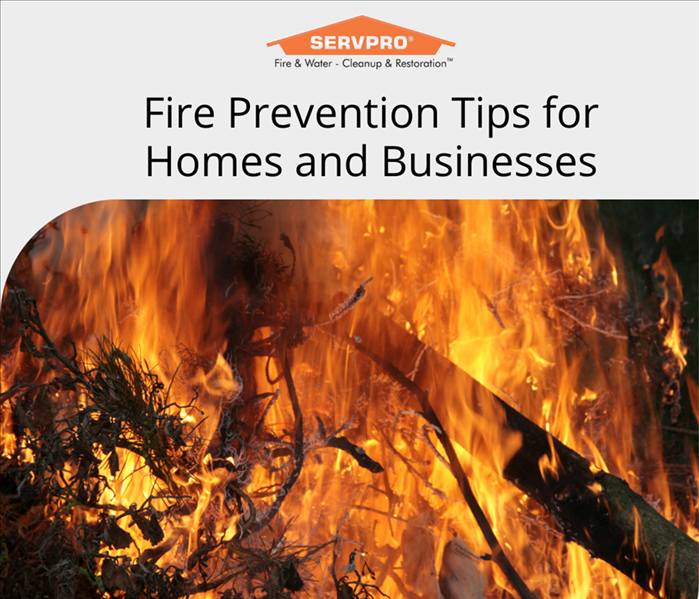 Preventing fires not only protects your property but also ensures the safety of your family, employees, and customers.
Preventing fires not only protects your property but also ensures the safety of your family, employees, and customers.
Fire safety is a top priority for homeowners and business owners alike. Preventing fires not only protects your property but also ensures the safety of your family, employees, and customers. Understanding key fire prevention strategies can help minimize risks and keep your space secure.
1. Install and Maintain Smoke Alarms
Why It Matters:
Smoke alarms provide early detection, allowing you to react quickly and prevent fire-related tragedies.
For Homes:
- Install smoke alarms in every bedroom, outside sleeping areas, and on all levels of your home.
- Test alarms monthly and replace batteries annually.
- Replace smoke detectors every 10 years.
For Businesses:
- Position smoke alarms in high-risk areas such as kitchens, break rooms, and storage rooms.
- Ensure all fire detection systems are functional and meet safety regulations.
2. Practice Safe Cooking Habits
Why It Matters:
Cooking fires are one of the leading causes of home and business fire incidents.
- Never leave cooking food unattended.
- Keep flammable materials like towels, curtains, and paper away from stoves.
- Restaurants and businesses with kitchens should provide fire safety training for employees.
3. Use Electrical Systems Safely
Why It Matters:
Electrical malfunctions, faulty wiring, and overloaded circuits can easily ignite fires.
- Avoid overloading electrical outlets and power strips.
- Regularly inspect cords for damage and replace frayed or worn ones.
- Hire licensed electricians to inspect and repair electrical systems as needed.
4. Store Flammable Materials Properly
Why It Matters:
Flammable liquids and materials can ignite quickly if not handled with care.
- Store flammable substances in original containers and keep them away from heat sources.
- Businesses should follow OSHA guidelines for handling and storing hazardous materials.
5. Create and Practice a Fire Escape Plan
Why It Matters:
A well-planned fire escape strategy can mean the difference between safety and disaster.
For Homes:
- Develop an evacuation plan with two exits per room.
- Establish a designated outdoor meeting spot.
- Conduct fire drills with family members regularly.
For Businesses:
- Implement an emergency action plan with clear exit routes.
- Conduct regular fire drills to ensure employees are prepared.
- Post evacuation maps in visible locations.
6. Use Heating Equipment Safely
Why It Matters:
Improper use of heating equipment, space heaters, and fireplaces increases fire risks.
- Keep space heaters at least three feet away from flammable objects.
- Clean and inspect chimneys and fireplaces annually.
7. Install Fire Suppression Systems
Why It Matters:
Fire extinguishers and sprinkler systems can prevent small fires from spreading.
- Keep fire extinguishers easily accessible in key areas.
- Businesses should invest in automatic sprinkler systems for added protection.
Fire Damage Restoration and Recovery
Even with strong fire prevention measures, fires can still occur. Having a reliable fire damage restoration plan is crucial for quick recovery. Our expert team specializes in:
? Smoke and soot cleanup
? Odor removal
? Structural repairs
As a trusted leader in fire damage restoration, Norwood/West Roxbury provides professional services with advanced equipment and expert training. Protect your home and business with proactive fire safety measures today!
A Healthy Home for a Healthy Heart: Simple Ways to Protect Your Well-Being
2/12/2025 (Permalink)
 February is American Heart Month, a time to raise awareness about cardiovascular health and the steps we can take to protect our hearts.
February is American Heart Month, a time to raise awareness about cardiovascular health and the steps we can take to protect our hearts.
February is American Heart Month, a time to raise awareness about cardiovascular health and the steps we can take to protect our hearts.
While diet, exercise, and regular check-ups are essential, one often-overlooked factor in heart health is your home environment. The air you breathe, the cleanliness of your space, and even the level of stress in your home can all impact your cardiovascular well-being.
By making a few intentional changes, you can create a heart-healthy home that supports your overall wellness. Here’s how:
Improve Indoor Air Quality for a Stronger Heart
The quality of the air in your home plays a crucial role in your health. Pollutants like dust, mold, and airborne toxins can trigger inflammation, respiratory issues, and even increase stress—factors that put unnecessary strain on your heart.
Heart-Healthy Home Tips:
- Clean Regularly: Reduce allergens by dusting, vacuuming with a HEPA filter, and washing bedding frequently.
- Control Humidity: Keep indoor humidity between 30-50% to prevent mold growth.
- Change Air Filters: Replace HVAC filters every 1-3 months to maintain clean air circulation.
- Let Fresh Air In: Open windows when weather permits to improve ventilation.
Reduce Stress by Decluttering
A cluttered space can lead to feelings of overwhelm and anxiety, both of which can contribute to high blood pressure and increased heart strain. Keeping an organized home can create a sense of calm and relaxation.
Heart-Healthy Home Tips:
- Declutter in Small Steps: Spend 10 minutes a day tidying up to maintain order.
- Organize for Functionality: Keep items in easy-to-access places to reduce frustration.
- Create Relaxation Spaces: Designate a cozy corner for reading, meditation, or unwinding.
Prevent Mold and Moisture Buildup
Mold spores in the air can lead to respiratory problems and increase inflammation, which is linked to heart disease. Since mold thrives in damp conditions, taking proactive measures can help keep your home mold-free.
Heart-Healthy Home Tips:
- Address Leaks Quickly: Repair water damage immediately to prevent mold growth.
- Use Exhaust Fans: Keep air moving in kitchens, bathrooms, and laundry rooms.
- Inspect for Hidden Mold: Check under sinks, behind appliances, and in basements regularly.
Minimize Chemical Exposure
Many cleaning products, air fresheners, and synthetic materials contain volatile organic compounds (VOCs), which can negatively impact air quality and cause stress on the body—including your heart.
Heart-Healthy Home Tips:
- Switch to Natural Cleaners: Use simple, non-toxic solutions like vinegar, baking soda, and lemon.
- Read Labels Carefully: Choose low-VOC or fragrance-free cleaning products.
- Ventilate When Cleaning: Open windows and run fans to improve airflow and reduce exposure.
Make Your Home a Safe Haven
A safe, well-maintained home reduces risks that can contribute to stress, injuries, or health emergencies. Preventing falls, improving fire safety, and ensuring proper lighting can create a more secure environment.
Heart-Healthy Home Tips:
- Install Smoke & Carbon Monoxide Detectors: Ensure alarms are working and placed in key areas.
- Eliminate Trip Hazards: Secure loose rugs, clear walkways, and remove clutter from floors.
- Improve Lighting: Use bright, well-placed lighting to prevent falls and reduce eye strain.
Your Heart Deserves a Healthy Home
Caring for your heart isn’t just about diet and exercise—it’s also about creating an environment that promotes overall well-being. By making your home a cleaner, safer, and more peaceful space, you can support your cardiovascular health and improve your quality of life.
If your home has been affected by water damage, mold, or poor air quality, our team at SERVPRO of Norwood/West Roxbury is here to help. As a trusted leader in home restoration, we have the expertise and advanced equipment to restore your home to a safe and healthy condition.
Why SERVPRO Is the Go-To Partner for Insurance Professionals
2/4/2025 (Permalink)
 When disaster strikes, trust SERVPRO of Norwood/West Roxbury to be the reliable, efficient partner your insurance team needs.
When disaster strikes, trust SERVPRO of Norwood/West Roxbury to be the reliable, efficient partner your insurance team needs.
When disaster strikes, property owners turn to their insurance companies for swift recovery. In turn, insurance professionals need a restoration partner they can count on—one that delivers consistent results, efficient processes, and exceptional service. SERVPRO has earned the trust of insurance professionals nationwide by providing seamless collaboration and expert claims handling to ensure smooth, successful outcomes.
A Proven Process Designed for Insurance Success
With a strong focus on rapid response, damage mitigation, and efficient restoration, SERVPRO supports insurance professionals at every step of the claims process. Here’s how:
1. 24/7 Rapid Response to Minimize Damage
Time is critical in restoration, and SERVPRO understands the urgency. With a network of over 2,000 franchise locations, help is always close by. Whether dealing with water, fire, mold, or storm damage, SERVPRO teams respond within hours—minimizing secondary damage and lowering overall claim costs.
2. Transparent Communication & Comprehensive Documentation
Clear, accurate information is essential for effective claims processing. SERVPRO provides thorough documentation at every stage, including:
? High-quality photos of damage and restoration progress
? Itemized estimates for precise cost assessment
? Daily job updates to keep adjusters and agents informed
? Proof of restoration completion for a seamless claims process
This level of transparency eliminates surprises, streamlines claims handling, and keeps all stakeholders on the same page.
3. Cutting-Edge Technology for Efficient Claims Management
SERVPRO utilizes advanced restoration techniques and proprietary software to track projects and document progress in real time. Insurance professionals can access up-to-date reports, ensuring a smooth and efficient workflow.
4. Standardized Pricing for Fair & Consistent Estimates
SERVPRO’s pricing aligns with industry standards, using the same estimating software as insurance companies. This ensures fair, consistent, and accurate cost assessments for every job.
5. Industry-Leading Training & Certification
SERVPRO team members undergo extensive training to stay current with industry best practices. Certified in a wide range of restoration scenarios—including complex commercial claims—they bring expertise and professionalism to every job.
More Than Restoration—A True Insurance Partner
Insurance professionals choose SERVPRO not just for restoration, but for the peace of mind that comes with a trusted, experienced partner. By streamlining claims, reducing costs, and exceeding customer expectations, SERVPRO has become the preferred restoration provider for insurance companies of all sizes.
When disaster strikes, trust SERVPRO of Norwood/West Roxbury to be the reliable, efficient partner your insurance team needs. With advanced training, state-of-the-art equipment, and a commitment to excellence, we’re ready to restore homes and businesses—quickly and professionally.
Preparing Your Home or Business for Storm Season
1/21/2025 (Permalink)
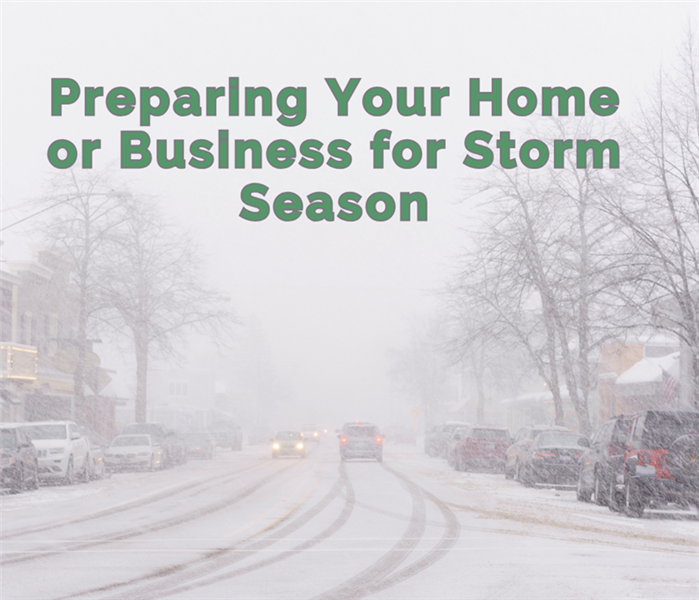 When storms strike, you can rely on us to help you recover and restore your property with professionalism and care.
When storms strike, you can rely on us to help you recover and restore your property with professionalism and care.
Storm season can bring unexpected challenges, but with the right preparation, you can protect your property and reduce potential damage.
Steps to Fortify Your Property
Seal Windows and Doors
Inspect for gaps and use weatherproofing materials to prevent water intrusion.
Maintain Gutters and Downspouts
Remove debris to ensure proper water flow and reduce the risk of flooding.
Secure Outdoor Items
Bring in or anchor down outdoor furniture, tools, and equipment to prevent them from becoming projectiles during high winds.
The Importance of an Emergency Plan
Being prepared with a solid emergency plan is essential for safety and quick recovery. Be sure to include:
Emergency Contacts
Keep important numbers handy, including SERVPRO’s, for fast restoration services.
Evacuation Routes and Safe Shelter
Identify safe spaces and the best paths to reach them during a storm.
Essential Documents and Valuables
Protect important paperwork and valuables by storing them in waterproof containers.
From severe flooding to wind damage, we specializes in restoring properties after storms. Our services include:
Rapid Response
Quick action minimizes downtime and limits further damage.
Expert Training and Advanced Equipment
SERVPRO of Norwood/West Roxbury is equipped to restore your home or business efficiently and effectively.
When storms strike, you can rely on us to help you recover and restore your property with professionalism and care. Stay prepared and stay safe!
Fire Damage: Steps to Take Before Help Arrives
1/16/2025 (Permalink)
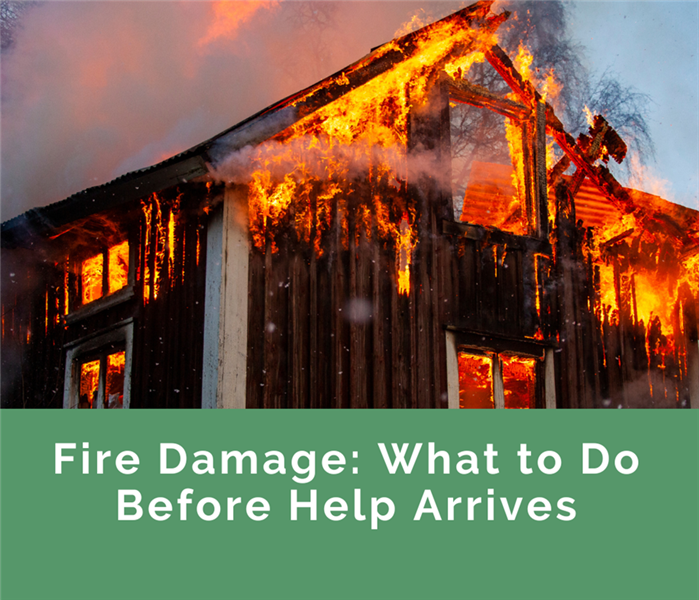 Follow this guide to manage fire damage safely until professional assistance arrives.
Follow this guide to manage fire damage safely until professional assistance arrives.
Experiencing a fire can be overwhelming, but taking the right actions immediately afterward can make a significant difference. Follow this guide to manage fire damage safely until professional assistance arrives.
1. Prioritize Safety
Your safety is the top priority. Do not re-enter the property until the fire department has confirmed it is safe. Fire-damaged buildings may have structural issues, lingering smoke, or electrical hazards that pose serious risks.
2. Document the Damage
When it’s safe, take detailed photos and videos of the damage. Proper documentation is essential for filing insurance claims and ensuring you receive appropriate compensation.
3. Avoid Cleaning on Your Own
Fire and smoke damage require professional cleaning techniques. Attempting to clean soot or smoke-damaged areas yourself can worsen the damage or spread contaminants. Leave the restoration process to trained experts.
4. Rely on Professional Restoration Services
When our team arrives, we’ll evaluate the damage, develop a detailed restoration plan, and start the process of cleaning, deodorizing, and repairing your property. Our expertise ensures effective restoration, even in cases of severe fire damage.
At Norwood/West Roxbury, we are a trusted leader in the restoration industry. With advanced training and specialized equipment, we’re ready to restore your home or business to its pre-fire condition.
The Hidden Dangers of Mold and How We Can Help
1/9/2025 (Permalink)
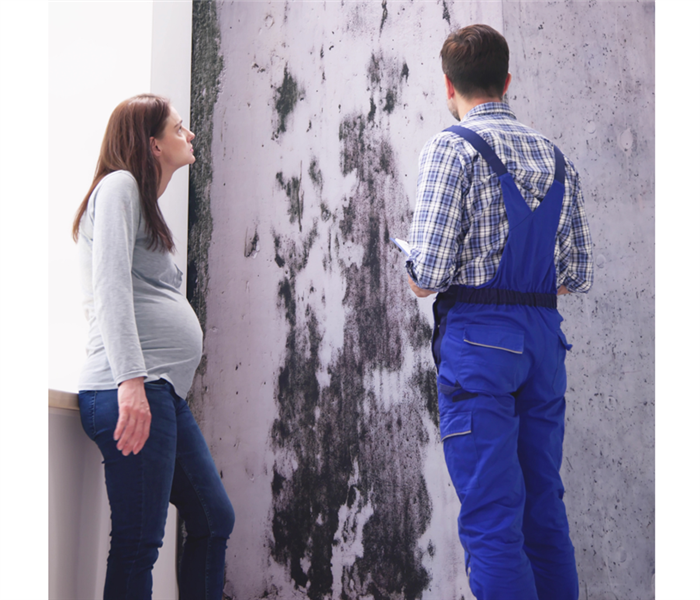 Mold may begin as a minor nuisance, but if left unchecked, it can escalate into a severe structural hazard.
Mold may begin as a minor nuisance, but if left unchecked, it can escalate into a severe structural hazard.
Mold may begin as a minor nuisance, but if left unchecked, it can escalate into a severe structural hazard. Here’s what you need to know about mold’s risks and how we can assist you in addressing them.
Common Causes of Mold in Homes and Businesses
Mold thrives in damp, humid conditions, making it a common problem in spaces affected by:
- Water damage or flooding
- Plumbing leaks
- Poor ventilation or high humidity
Areas like bathrooms, basements, and spots prone to condensation are particularly susceptible.
Signs You Need Professional Mold Removal
If you notice any of the following, it’s time to call in the experts:
- Persistent musty odors
- Discoloration or stains on walls, ceilings, or floors
- Recurring moisture issues
SERVPRO’s Comprehensive Mold Remediation Process
Our team of trained professionals doesn’t just remove mold—we target it at its source to prevent future issues. Our process includes:
- Thorough Inspection: Identifying the extent of the mold problem.
- Containment: Preventing the spread of mold spores during cleanup.
- Effective Removal: Using advanced techniques and equipment to safely eliminate mold.
- Restoration: Repairing and restoring affected areas to their original condition.
Preventive Tips to Keep Mold Away
To reduce the risk of mold growth, follow these tips:
- Maintain indoor humidity levels below 60%.
- Address leaks and water damage immediately.
- Ensure proper ventilation in areas prone to moisture, like kitchens and bathrooms.
As a trusted restoration leader, SERVPRO of Norwood/West Roxbury combines advanced training and state-of-the-art equipment to ensure your home or business is mold-free and fully restored. Reach out today for reliable, professional assistance!
Top 5 Reasons to Call Us After Water Damage
1/1/2025 (Permalink)
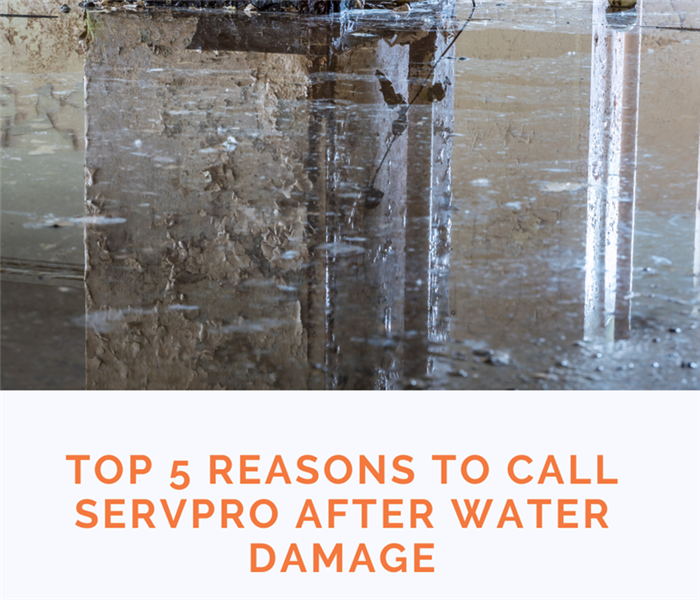 Water damage can catch you off guard, leaving your home or business at risk of severe, long-lasting consequences if not addressed immediately.
Water damage can catch you off guard, leaving your home or business at risk of severe, long-lasting consequences if not addressed immediately.
Water damage can catch you off guard, leaving your home or business at risk of severe, long-lasting consequences if not addressed immediately. Here’s why reaching out to us after water damage is the smartest decision you can make:
1. Immediate Action Stops Mold in Its Tracks
Mold can start growing within 24-48 hours after water damage occurs. Our team acts fast to mitigate damage and stop mold growth before it becomes a larger, more costly issue.
2. Advanced Water Extraction and Drying Technology
We utilize state-of-the-art tools and equipment to remove water efficiently, even from hard-to-reach places like behind walls and under floors. Our thorough approach ensures no moisture is left behind, reducing the risk of further structural damage.
3. Experienced Professionals for Total Peace of Mind
With extensive experience in water damage restoration, our trained technicians handle every situation with expertise and care. Whether dealing with a small leak or a major flood, we’ll restore your property quickly, safely, and efficiently.
4. Insurance Claims Made Simple
Navigating insurance claims can be daunting after water damage. We work directly with your insurance provider to streamline the process, offering detailed documentation and expertise to ensure you receive the compensation you deserve.
5. Proven Results That Speak for Themselves
We’ve helped countless homeowners and businesses recover from water damage. From saving a flooded basement after a pipe burst to helping businesses reopen after storm damage, our success stories highlight the trust and results we deliver.
Don’t let water damage take a toll on your property. As a trusted leader in the restoration industry, Norwood/West Roxbury is equipped with the training and tools to restore your home or business to its pre-damage condition.
Commercial Restoration: Protecting Your Business from Disaster and Getting Back on Track
12/17/2024 (Permalink)
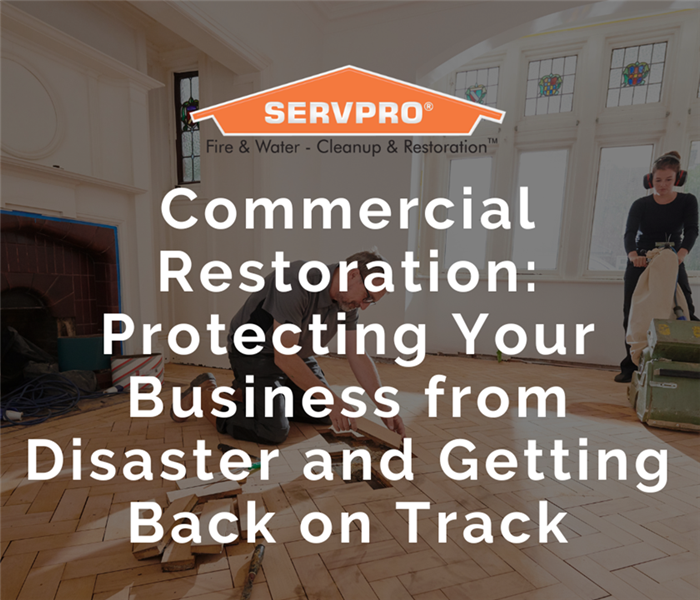 At Norwood/West Roxbury, we combine advanced training with industry-leading equipment to restore your business efficiently and effectively.
At Norwood/West Roxbury, we combine advanced training with industry-leading equipment to restore your business efficiently and effectively.
When disaster strikes—whether from water, fire, mold, or severe weather—the consequences can feel overwhelming. Beyond disrupting daily operations, the damage can impact your employees, customers, and bottom line. Swift commercial restoration is essential to help businesses recover quickly and effectively. This guide explores the restoration process, common types of damage, and proactive steps to safeguard your business against future disasters.
Why Commercial Restoration is Crucial
Every moment your business remains closed translates to lost revenue and productivity. Rapid restoration minimizes disruption, helping your business rebound while ensuring a safe environment for employees and customers. Expert restoration teams handle cleanup, repairs, and prevention, allowing you to focus on rebuilding with confidence.
Common Types of Commercial Damage
Water Damage
- Causes: Burst pipes, roof leaks, flooding, or faulty sprinkler systems.
- Impact: Leads to mold growth, structural damage, and ruined equipment or inventory.
- Restoration Process: Includes water extraction, drying, dehumidification, and thorough monitoring to eliminate residual moisture.
Fire and Smoke Damage
- Causes: Electrical malfunctions, kitchen fires, or industrial accidents.
- Impact: Fire often leaves behind smoke, soot, and odors that require specialized treatment.
- Restoration Process: Soot removal, deodorizing, and deep-cleaning to prevent further damage to walls, furniture, and equipment.
Mold and Fungal Growth
- Causes: High humidity, previous water damage, or poor ventilation.
- Impact: Damages walls, floors, and HVAC systems while posing health risks.
- Restoration Process: Includes containment, air filtration, mold removal, and preventative measures to stop future growth.
Storm and Wind Damage
- Causes: Hurricanes, tornadoes, heavy rains, and high winds.
- Impact: Broken windows, roof leaks, downed trees, and flooded areas.
- Restoration Process: Structural repairs, debris removal, water extraction, and necessary construction.
The Commercial Restoration Process
1. Assessment and Inspection
- On-site evaluations determine the extent of damage and create a tailored restoration plan.
- May include moisture mapping, air quality testing, and structural inspections.
2. Mitigation and Containment
- Immediate actions to prevent further damage, such as boarding windows or tarping roofs.
- For water or mold damage, this includes water extraction and dehumidification.
3. Cleanup and Removal
- Damaged materials (e.g., drywall, flooring, furniture) are removed.
- Specialized cleaning eliminates soot, mold, and water residue, ensuring safety.
4. Restoration and Repair
- Repairs and replacements include structural rebuilding, repainting, and refinishing.
- Odor removal and deep cleaning ensure a safe, welcoming environment.
5. Final Inspection and Prevention Recommendations
- Comprehensive inspections confirm the property is fully restored.
- Experts often suggest preventative upgrades like fireproofing or moisture control.
Choosing a Reliable Restoration Partner
Selecting the right restoration company is crucial for seamless recovery. Look for a provider with:
- 24/7 Availability: Fast response times are vital to minimizing damage.
- Advanced Equipment: Commercial spaces often require specialized tools and techniques.
- Knowledge of Codes: Compliance with local regulations ensures safety and avoids legal issues.
- Project Management Expertise: Coordinating contractors, permits, and inspections simplifies complex restoration efforts.
Preparing Your Business for Future Disasters
1. Conduct Regular Maintenance
- Inspect plumbing, HVAC, electrical, and roofing systems to address issues early.
2. Improve Waterproofing
- Seal foundation cracks, ensure proper drainage, and consider water-resistant barriers.
3. Develop a Disaster Plan
- Outline evacuation routes, emergency contacts, and data protection measures.
4. Upgrade Fire Safety Systems
- Test alarms, sprinklers, and extinguishers to meet current standards.
5. Review Insurance Coverage
- Ensure your policy includes disaster recovery and business interruption coverage.
Facing a disaster can be challenging, but with the right team and preparation, your business can recover quickly. Whether dealing with water, fire, mold, or storm damage, proactive planning and quick restoration ensure minimal disruption and a smoother return to normal operations.
At Norwood/West Roxbury, we combine advanced training with industry-leading equipment to restore your business efficiently and effectively.
Frozen Pipes and Ice Dams: What to Do If You Return to Winter Water Damage
12/10/2024 (Permalink)
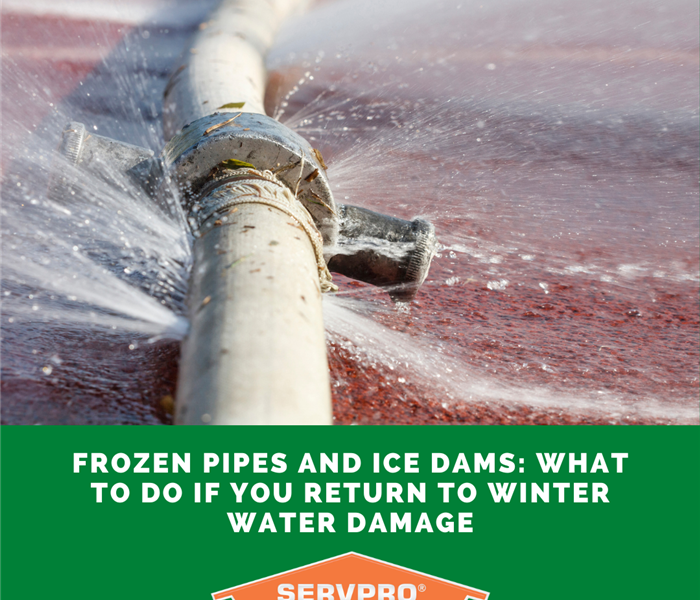 SERVPRO Norwood/West Roxbury has the expertise, training, and equipment to restore your home after water damage.
SERVPRO Norwood/West Roxbury has the expertise, training, and equipment to restore your home after water damage.
Winter vacations offer a chance to unwind, but coming home to frozen pipes or water damage can quickly undo that relaxation. When temperatures drop, frozen pipes and ice dams become significant risks, leading to costly repairs if not addressed promptly. Here's how to identify and manage these winter hazards—and steps you can take to prevent them in the future.
1. Understanding the Risks: Frozen Pipes and Ice Dams
Frozen Pipes: As temperatures plummet, water inside your pipes can freeze and expand, causing cracks or bursts. Once the ice thaws, water may flood your home, resulting in extensive damage.
Ice Dams: These form when snow on your roof melts and refreezes at the edges, creating a barrier that blocks water runoff. Trapped water can seep into your home, damaging walls, ceilings, and insulation.
2. Signs of Frozen Pipes or Ice Dam Damage
Check your home for these common indicators of winter-related water damage:
- Water Stains: Look for discoloration on walls or ceilings, which may signal leaks from ice dams.
- Low Water Pressure: Weak water flow could mean frozen pipes are blocking water.
- Pooling Water or Dampness: Inspect basements, exterior walls, and areas under sinks for unexpected moisture.
- Frost on Pipes: Visible frost on pipes in unheated spaces, such as attics or crawl spaces, often points to freezing.
3. Immediate Steps to Take
If you discover water damage, act quickly to minimize further issues:
- Shut Off the Water: Turn off your home's main water supply to stop leaks from burst pipes.
- Cut Power to Affected Areas: Avoid electrical hazards by shutting off power in flooded rooms.
- Drain Pipes: Open all faucets to relieve pressure and release any remaining water.
- Remove Standing Water: Use towels or a wet-dry vacuum to prevent mold growth on wet surfaces like carpets or hardwood floors.
4. Thawing Frozen Pipes
If pipes are frozen but intact, follow these safe thawing tips:
- Gradual Heating: Use a hair dryer, heating pad, or space heater to warm frozen pipes. Avoid open flames or extreme heat.
- Start with Exposed Pipes: Thaw pipes that are easiest to access before moving to hidden areas.
- Keep Faucets Open: Allow a small trickle of water to run as you thaw pipes to promote flow and speed up the process.
5. Addressing Ice Dam Damage
Ice dams can lead to hidden water damage. Here’s how to handle it:
- Inspect Insulation: Replace any wet or damaged attic insulation to prevent mold.
- Examine Walls and Ceilings: Address damp spots or discoloration immediately.
- Dehumidify Affected Areas: After removing standing water, use a dehumidifier to eliminate lingering moisture.
6. When to Call the Experts
While minor damage can often be managed on your own, you’ll need professional help if:
- Flooding or water damage is extensive.
- Mold has developed.
- Water has compromised electrical systems or insulation.
Professional restoration services have advanced tools like industrial dehumidifiers and moisture meters to ensure thorough cleanup and repair.
7. Preventing Future Frozen Pipes and Ice Dams
Take these proactive steps to protect your home:
- Insulate Pipes: Use foam or insulation tape to keep pipes warm.
- Let Faucets Drip: Allow faucets to run slightly during extreme cold to prevent freezing.
- Improve Attic Insulation and Ventilation: Proper insulation slows snow melt and reduces ice dam formation.
- Clean Gutters: Clear debris to ensure proper water flow off your roof.
8. Preparing Your Home Before Winter Travels
Before heading out on a winter vacation, take precautions to avoid coming home to water damage:
- Set the Thermostat: Keep the temperature at 55°F or higher to prevent freezing.
- Turn Off the Water Supply: If possible, shut off and drain your pipes.
- Open Cabinets: Allow warm air to reach pipes in unheated areas.
Winter water damage can be a major headache, but acting quickly and following these tips can minimize the impact and safeguard your home.
SERVPRO Norwood/West Roxbury has the expertise, training, and equipment to restore your home after water damage. Trust us to help you recover quickly and protect your property from future issues.
Frozen Pipes and Ice Dams: What to Do If You Return to Winter Water Damage
12/10/2024 (Permalink)
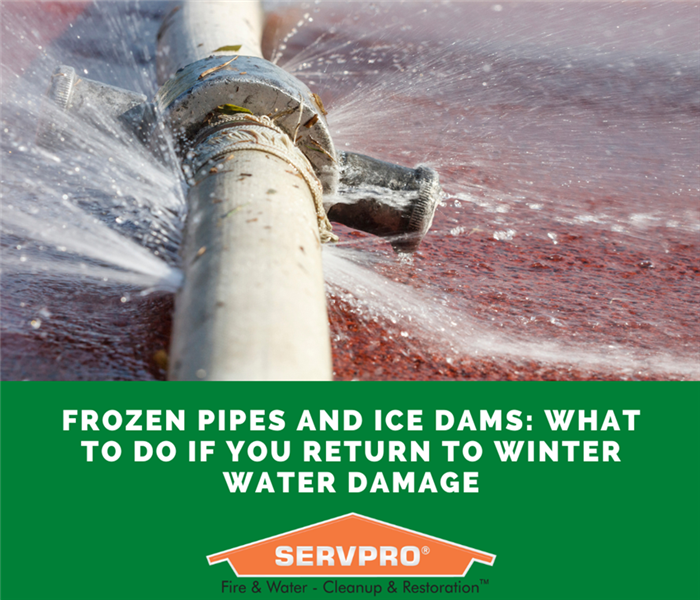 SERVPRO Norwood/West Roxbury has the expertise, training, and equipment to restore your home after water damage.
SERVPRO Norwood/West Roxbury has the expertise, training, and equipment to restore your home after water damage.
Winter vacations offer a chance to unwind, but coming home to frozen pipes or water damage can quickly undo that relaxation. When temperatures drop, frozen pipes and ice dams become significant risks, leading to costly repairs if not addressed promptly. Here's how to identify and manage these winter hazards—and steps you can take to prevent them in the future.
1. Understanding the Risks: Frozen Pipes and Ice Dams
Frozen Pipes: As temperatures plummet, water inside your pipes can freeze and expand, causing cracks or bursts. Once the ice thaws, water may flood your home, resulting in extensive damage.
Ice Dams: These form when snow on your roof melts and refreezes at the edges, creating a barrier that blocks water runoff. Trapped water can seep into your home, damaging walls, ceilings, and insulation.
2. Signs of Frozen Pipes or Ice Dam Damage
Check your home for these common indicators of winter-related water damage:
- Water Stains: Look for discoloration on walls or ceilings, which may signal leaks from ice dams.
- Low Water Pressure: Weak water flow could mean frozen pipes are blocking water.
- Pooling Water or Dampness: Inspect basements, exterior walls, and areas under sinks for unexpected moisture.
- Frost on Pipes: Visible frost on pipes in unheated spaces, such as attics or crawl spaces, often points to freezing.
3. Immediate Steps to Take
If you discover water damage, act quickly to minimize further issues:
- Shut Off the Water: Turn off your home's main water supply to stop leaks from burst pipes.
- Cut Power to Affected Areas: Avoid electrical hazards by shutting off power in flooded rooms.
- Drain Pipes: Open all faucets to relieve pressure and release any remaining water.
- Remove Standing Water: Use towels or a wet-dry vacuum to prevent mold growth on wet surfaces like carpets or hardwood floors.
4. Thawing Frozen Pipes
If pipes are frozen but intact, follow these safe thawing tips:
- Gradual Heating: Use a hair dryer, heating pad, or space heater to warm frozen pipes. Avoid open flames or extreme heat.
- Start with Exposed Pipes: Thaw pipes that are easiest to access before moving to hidden areas.
- Keep Faucets Open: Allow a small trickle of water to run as you thaw pipes to promote flow and speed up the process.
5. Addressing Ice Dam Damage
Ice dams can lead to hidden water damage. Here’s how to handle it:
- Inspect Insulation: Replace any wet or damaged attic insulation to prevent mold.
- Examine Walls and Ceilings: Address damp spots or discoloration immediately.
- Dehumidify Affected Areas: After removing standing water, use a dehumidifier to eliminate lingering moisture.
6. When to Call the Experts
While minor damage can often be managed on your own, you’ll need professional help if:
- Flooding or water damage is extensive.
- Mold has developed.
- Water has compromised electrical systems or insulation.
Professional restoration services have advanced tools like industrial dehumidifiers and moisture meters to ensure thorough cleanup and repair.
7. Preventing Future Frozen Pipes and Ice Dams
Take these proactive steps to protect your home:
- Insulate Pipes: Use foam or insulation tape to keep pipes warm.
- Let Faucets Drip: Allow faucets to run slightly during extreme cold to prevent freezing.
- Improve Attic Insulation and Ventilation: Proper insulation slows snow melt and reduces ice dam formation.
- Clean Gutters: Clear debris to ensure proper water flow off your roof.
8. Preparing Your Home Before Winter Travels
Before heading out on a winter vacation, take precautions to avoid coming home to water damage:
- Set the Thermostat: Keep the temperature at 55°F or higher to prevent freezing.
- Turn Off the Water Supply: If possible, shut off and drain your pipes.
- Open Cabinets: Allow warm air to reach pipes in unheated areas.
Winter water damage can be a major headache, but acting quickly and following these tips can minimize the impact and safeguard your home.
SERVPRO Norwood/West Roxbury has the expertise, training, and equipment to restore your home after water damage. Trust us to help you recover quickly and protect your property from future issues.
 Preventing fires not only protects your property but also ensures the safety of your family, employees, and customers.
Preventing fires not only protects your property but also ensures the safety of your family, employees, and customers.





 24/7 Emergency Service
24/7 Emergency Service








